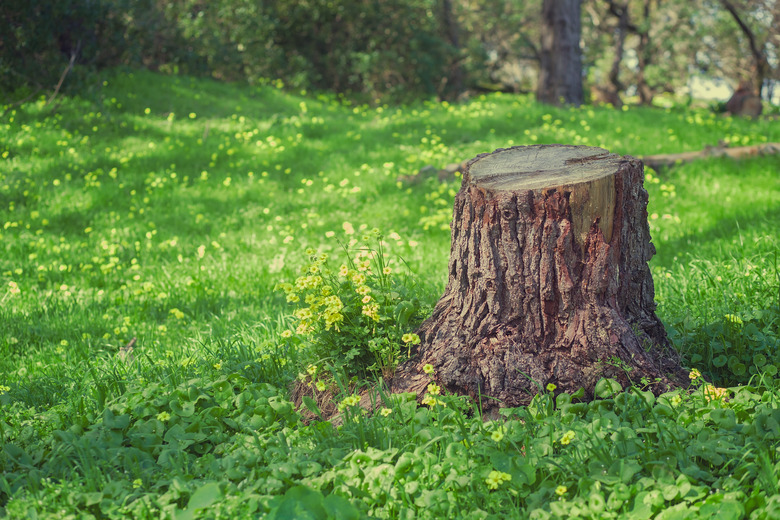How To Plant Grass Where A Tree Stump Was Located
We may receive a commission on purchases made from links.
Planting grass where a tree stump was isn't as easy as tossing down some soil and grass seed. Without proper site preparation, the grass will turn yellow and die every time it sprouts — if it sprouts at all. That's because microorganisms in the soil consume nitrogen along with the carbon in the tree stump. The surrounding grass suffers from a nutrient deficiency as a result.
Tree Stumps Affect Soil Nitrogen
Tree Stumps Affect Soil Nitrogen
The microorganisms responsible for breaking down nature's dead materials feast primarily on carbon, and a dead tree stump is a huge source of carbon. But they have other nutritional needs as well. In particular, they need nitrogen.
According to the USDA Natural Resources Conservation Service, these microorganisms need about 24 times as much carbon as they do nitrogen. The carbon serves as an energy source, whereas the nitrogen is essential for their cell structure. Once nitrogen is no longer available, the organisms die and the tree stump will stop decomposing.
Problems With Growing Grass
Problems With Growing Grass
Grass needs nitrogen too. In fact, nitrogen is essential for the growth and development of all plants. The microorganisms compete with grass for nitrogen in the soil. Due to their shallow root systems, most turf grasses can't get enough nitrogen and eventually turn yellow and die.
Any effort to cover an old stump location with fresh grass will be in vain without proper site clean up and/or fertilization. It's important to remember that you're not only fertilizing the grass, but also the microorganisms eating the old tree stump and roots. That means you need to apply more nitrogen than usual and for a longer period of time.
Planting Grass Over a Stump
Planting Grass Over a Stump
If you haven't already leveled out the stump area, start there. Stump grinding is an effective solution because it reaches below the soil line to pulverize as much of the stump and its roots as possible. Once the stump has been turned into a pile of sawdust, resist the urge to rake it out into the grass to create a level surface for new grass seed. Instead, scoop out as much of that sawdust as possible.
Removing the carbon-rich wood will prevent some of the soil's nitrogen from being lost. Next, fill in the hole with well-aged compost or manure. This will provide a nitrogen boost for both the microorganisms and the grass. Slightly overfill the hole to account for soil settling as the stump remnants continue to decay below the surface.
Sprinkle grass seed over the soil along with slow-release nitrogen pellets (also called water-insoluble nitrogen). The nitrogen will permeate the soil over the course of eight to 12 weeks and replace what's consumed by the microorganisms. Add another application every eight to 12 weeks or whenever the grass blades start to show streaks of yellow. If your existing grass needs a quick dose of nitrogen, apply a liquid fertilizer to help revive it.
Plant Clover With Grass
Plant Clover With Grass
If you don't have a lot of time or money to spend on frequent fertilizer applications, you can choose a natural solution: mixing clover (Trifolium spp.) seed with your grass seed. Clover's root nodules host nitrogen-fixing bacteria, which convert nitrogen from the atmosphere into a form that can be used by the clover.
To make this nitrogen available to the grass, leave clippings on the lawn after you mow. The nitrogen content in the clover will then become available to the grass as the clippings break down.
